Chris Parkin tries hard not to fall in love with this add-on, which converts Blaser’s exceptional R8 centrefire rifle into a rimfire alternative!
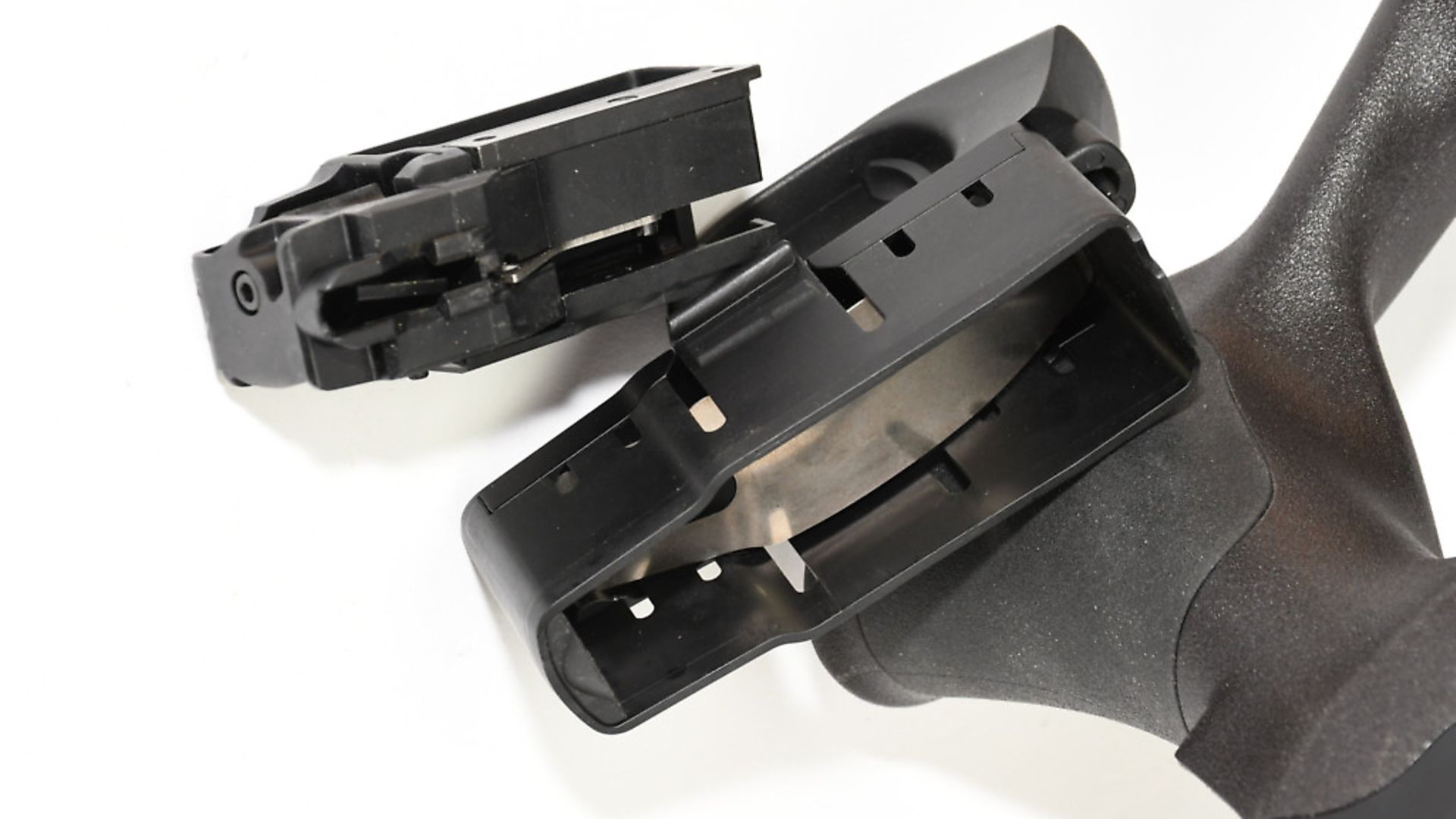 credit: Archant
credit: Archant
I have covered a lot of Blaser R8s over the last five years for Rifle Shooter and, frankly, they are too complex a subject for just a mini review, but this month I’m looking solely at the .22 rimfire conversion kit.
This kit includes a 22.8”/580mm barrel, magazine insert and bolt-face to adapt any current R8 to shoot .22 LR, opening up a whole world of shooting and training options with low-cost ammunition, lessened noise, space requirements and recoil for existing Blaser users.
Although any Blaser can be offered in a true left-hand version with stock and bolt-handle, the rimfire kit only has the one bolt-face option, so unlike its centrefire brothers, will only ever be a right-side ejector, although I will say that brass ejection is forwards almost 45° from the line of fire with more than a 2m throw, even in the prone position, so if you want a lefty, don’t worry for a moment – it’s not going to fly anywhere near your face!
By way of full disclosure, I should probably admit at this point that I am, strangely, not that into Blasers – simply because I can’t afford these mechanical marvels of amazing precision. If you are a Blaser shooter, I can easily see why you would only want the Blaser straight-pull rifles in your armoury, but the fact is that this kit means you only need one stock/chassis and a collection of barrels and scope sets to build a collection of Blasers in a range of calibres.
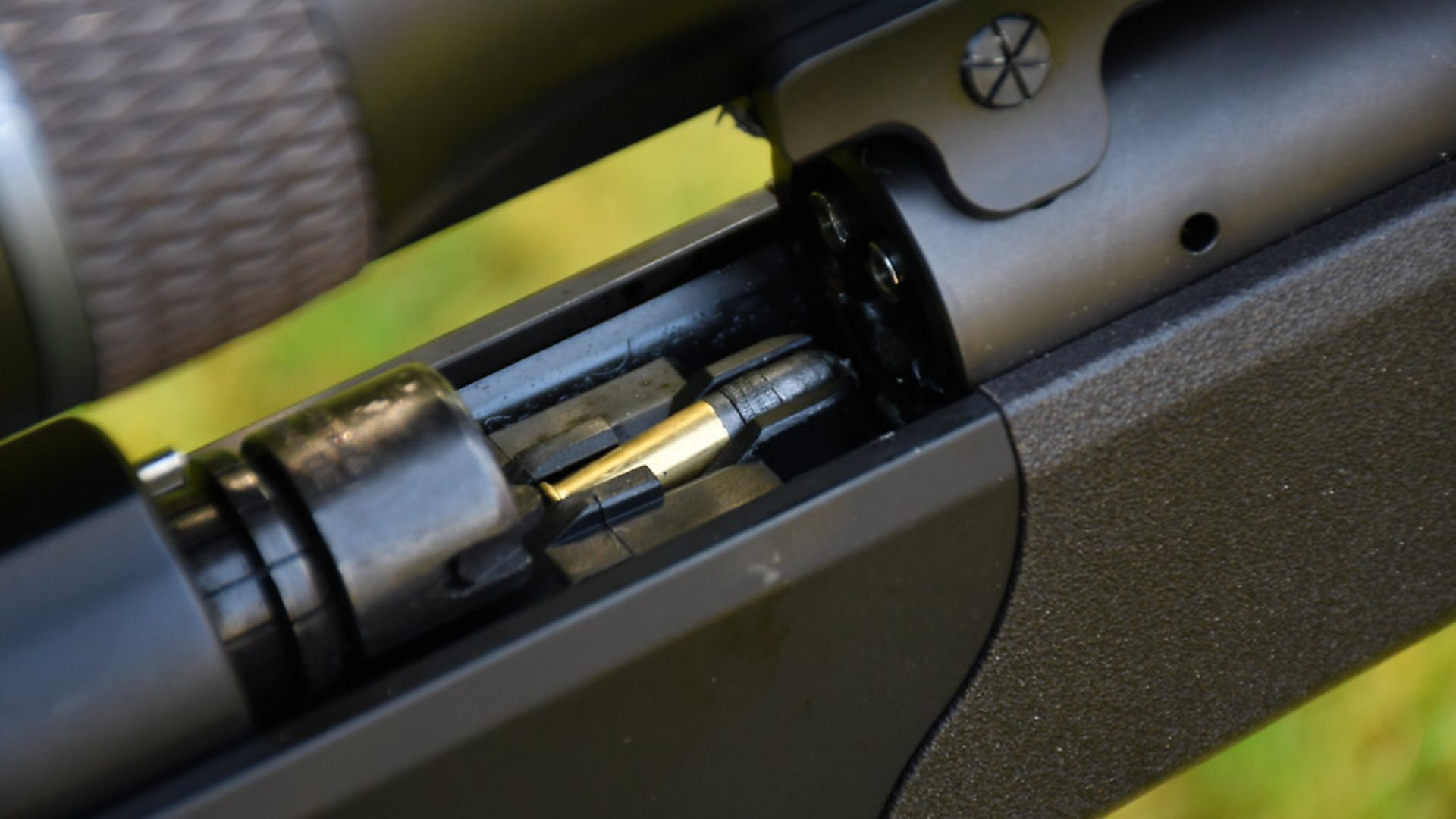 credit: Archant
credit: Archant
Rimfire mechanics
The 17mm rimfire barrel sports a 15x1 thread for a moderator sat on a truly floating fore-end. It’s stiff with no contact and shows sling studs on the tip and underside for a bipod. These are matched at the rear; just bear in mind they need slimmer 2.7mm diameter swivels rather than the more usual 3.3mm units.
The barrel is secured to the stock/chassis’ bedding block in the usual fashion with twin-retained Allen head fasteners and the whole gun can be stripped/barrels swapped in less than two minutes, even when exchanging mag/bolt-faces.
The big difference on this .22LR is the chamber, which features two long pins that telescope into the barrel as the bolt is closed. The pins are sprung and as the control-feed bolt strips a round from the mag it’s secured by twin claws; the plungers then pin it to the bolt face for its relatively long 61mm trip into the barrel.
There’s a slender ‘slide’ for it to run along, which sounds more complex than it is, demonstrating Blaser’s innovation and attention to detail when to comes to the problem of getting a tiny rimfire case from magazine to chamber without dropping it – this issue is commonly seen on regular bolt-action rifles with short stubby cases that are forced to traverse the gap over the abutments, and is the reason I tend to like longer slim cases rather than the short fatties for reliability in the field.
A wonderful intricate design that performed as well as any other bolt action rimfire I have used. A point to note is that because the brass case is eventually presented to the chamber in a straight line, you get far less bullet deformation and lead/waxy residue at the bolt face and barrel interface.
The specific six-round .22 rimfire insert clips into the regular Blaser magazine carrier/trigger/guard. It’s held in by twin lateral clips. There’s a locking button in the base of the follower spring to fix the unit in place for security, but it needs the .22 insert to be removed if you want to operate it.
It’s great to see Blaser have had to add complexity to the rifle yet lost none of the features and security. With the mag/trigger removed, the gun is totally inoperable; likewise, it needs to be withdrawn to remove the bolt. The bolt has a full 122mm travel, but with the .22 insert fitted, it’s reduced to 62mm with a secondary bolt stop integral to the mag. I’d love to illustrate all the added mechanical complexity, because while you never notice it in use, it is good to see it done so well. The rear de-cocker is present to release tension from the firing pin with just a forward push needed to re-initiate the rifle. This locks the bolt closed when rearward, with a half press needed to open the rifle’s chamber safely.
Fast straight-pull operation is the name of the game for Blaser, but until you have seen some of the competitors, you wouldn’t notice the elements that make the Blaser better. One such element is the pin that protrudes from the face of the bolt carrier, offering strong primary extraction as it levers against the steel face of the barrel. Not a big deal on a rimfire, but a reflection of the thought processes that went into making the gun so reliable.
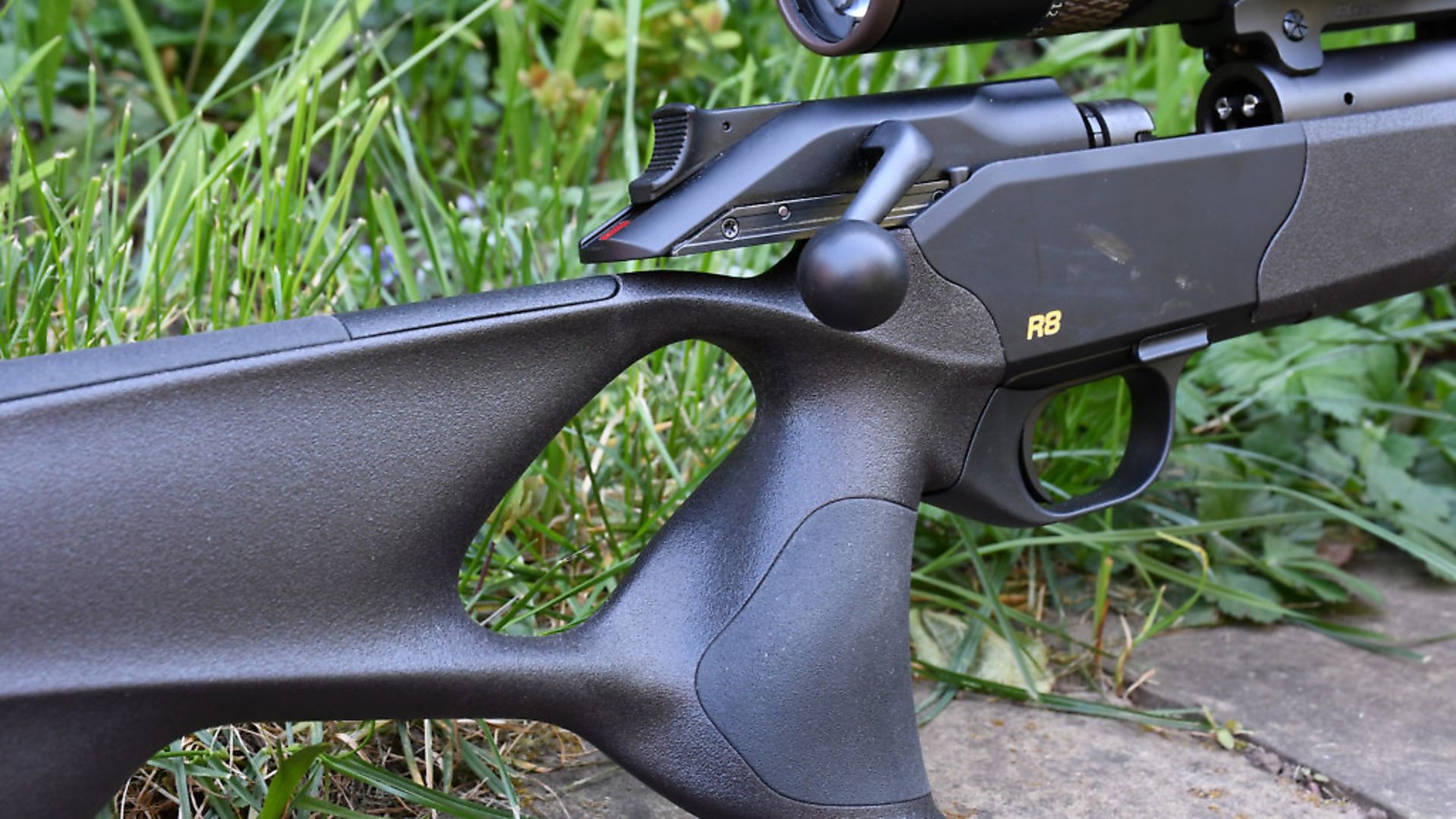 credit: Archant
credit: Archant
Stock style
As tested, this Ultimate stock incorporates an adjustable, slender comb (the adjustable butt can be added as an option). A two-position button press allows it to lift under sprung tension and a deeper press initiates a memory function to save it. This needs to be dropped to remove the bolt but even in its flush position (parallel to bore line), the cheek position is good with just a 2.5mm gap clearing the transit of the bolt.
The entire polymer surface has a stippled finish with rubberised copolymer-moulded inserts on the hand filling fore-end, and thumbhole grip. This is totally right-handed (lefty is an option) and although I wouldn’t always choose a thumbhole for a fast-handling rifle, I have to admit the ergonomics of the grip and balance of the rifle make it incredibly secure to hold with minimal muscle strain and tension.
Reach to trigger is perfect and Blaser triggers are a bit of an issue for me because they are (dare I say it) a mechanical masterpiece. I always thought a disconnected trigger that separated from the rifle would show weakness, but on the contrary, this single-stage unit, here breaking at 650g, is, like every other bloody Blaser, perfect. 99.9% crisp with a 2mm overtravel on its tip. You can have the additional ATZL trigger if you want but I see no need. That gives 250/650gr breaks in varmint/target and hunting modes but the 250gr is scary light and with a trigger this good as standard, I wouldn’t bother.
Finishing off, the underside of the butt has plenty of bulk for a supporting bag or fist to control elevation. It’s not a butt hook so much, but like the rest of the rifle, the organic flow to the shape and curves prevent any snagging and there’s no hollow resonant clunking from the stock if bumped.
The recoil pad completes a 370mm/14.5” length of pull, showing tactile surfacing with rounded edges to speed up gun mount, and stays planted and grippy in the shoulder.
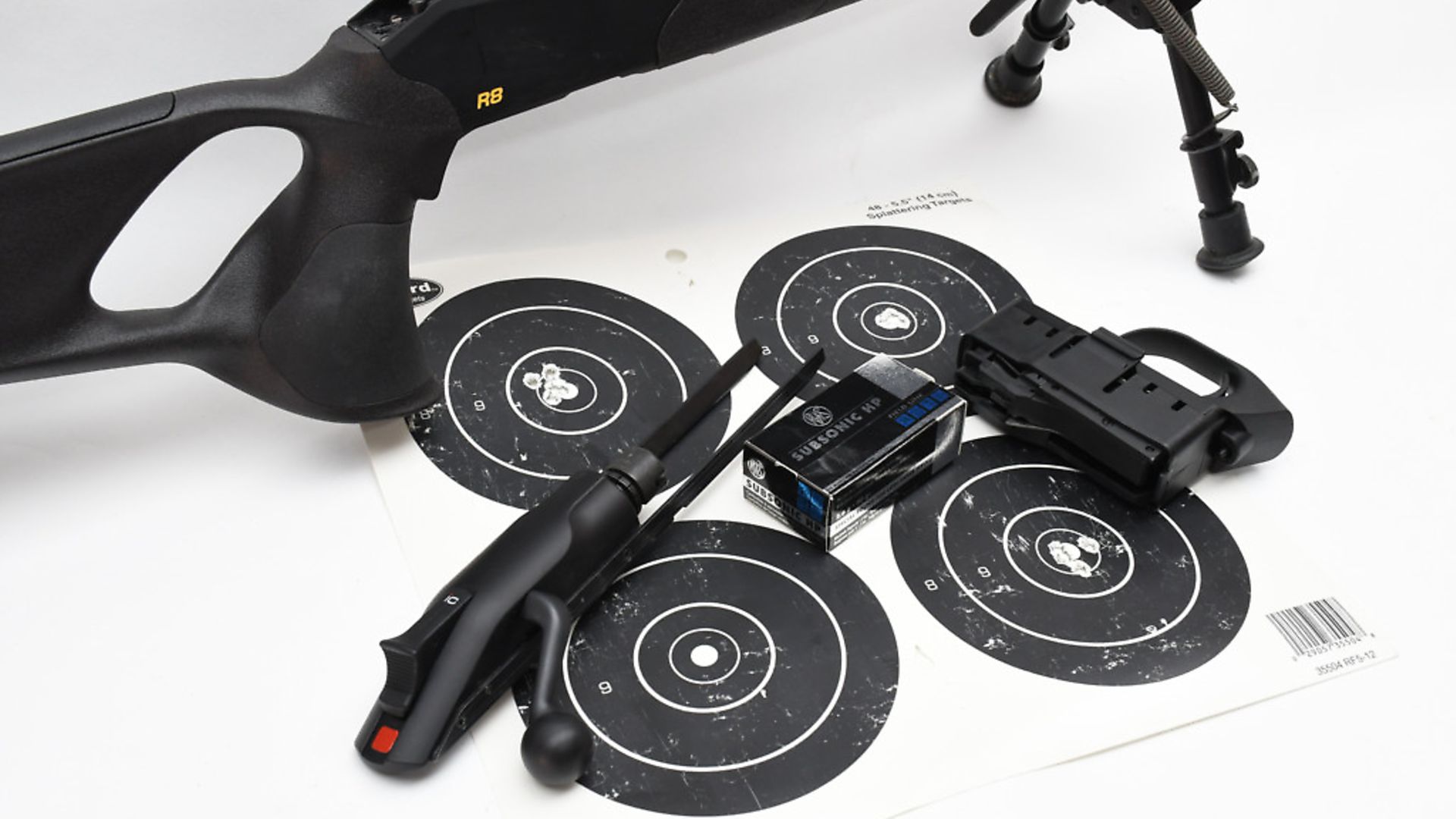 credit: Archant
credit: Archant
Shooting test
Shooting the rifle was pleasurable with the stock providing good positional control while the stiff fore-end and length of pull create consistent bipod loading. Very little positional movement is needed, with the head remaining stationary on the stock as the action is cycled and the gun firmly seated in the shoulder pocket.
From a distance, you can’t tell the gun is ‘only’ a rimfire as its 40.5”/1030m overall length is ‘normal’. Bare rifle weight of 3.63kg/8lb maintains the regular centrefire feel and although you need to be cautious of unburnt powder residue from any rimfire, there is nothing to stop you using an appropriate moderator across various calibres.
Scope mounting uses the proprietary saddle mount system and, given the calibre’s minimal ammo cost, I took the opportunity to test the return to zero, with it removed and refitted every time between three five-shot 50m groups. Simply put, it works – fast, reliable and maintains zero. If you want proof, watch my YouTube video.
I tried a mixture of 40-42gr subsonic loads through the test period, sadly restricted to just 50m by the current lockdown, but everything shot sub-1” at this distance, with perhaps a little slow overall average velocity around 1000 fps. But truly subsonic and quiet, which suits me perfectly. Best performance went to RWS HP subsonic which shot the tightest, most consistent groups, averaging sub-12.5mm/½” five-shot groups for 15 shots in the string, with the scope removed and refitted 15 times. I can’t think of a better way to illustrate the gun’s capability than that!
 credit: Archant
credit: Archant
Pros
- Blistering bolt speed
- The trigger is a masterpiece
- Superb stock ergonomics coupled to almost complete calibre modularity for any role
Cons
- I’m struggling here, I did get a couple of misfeeds but what rimmy hasn’t had one or two of those
Verdict
- Blaser already impress me with design ingenuity and precision but this 22 Rimfire conversion kit illustrates it beyond their current reputation alone. I have always been a bit frosty toward their doubtless mechanical brilliance, yet somehow in a lowly Rimfire, the R8 shows a quiet charm and personality all its own which has perhaps finally defrosted me.
Tech specs
Calibre: 22 Rimfire (others available)
Overall length: 1030mm/40.5”
Weight: 3.6kg/8lbs
Magazine: capacity, 5+1
Trigger: single stage, ~650gr pull weight
Barrel: length, 580mm/22.8”
Length of pull: 370mm (14.5”)
Safety catch: 2 position de-cocker with bolt locking (iC compatible)
RRPs
Rifle: £3,868 as tested including adjustable cheekpiece
Scope Mount: £418
Blaser 2.8-20x50 scope: £2724
22 Rimfire conversion kit alone: £1078
Contact: www.blaser-group.com
Ammunition used
Browning and Winchester: www.browning.eu
RWS: www.ruag.co.uk
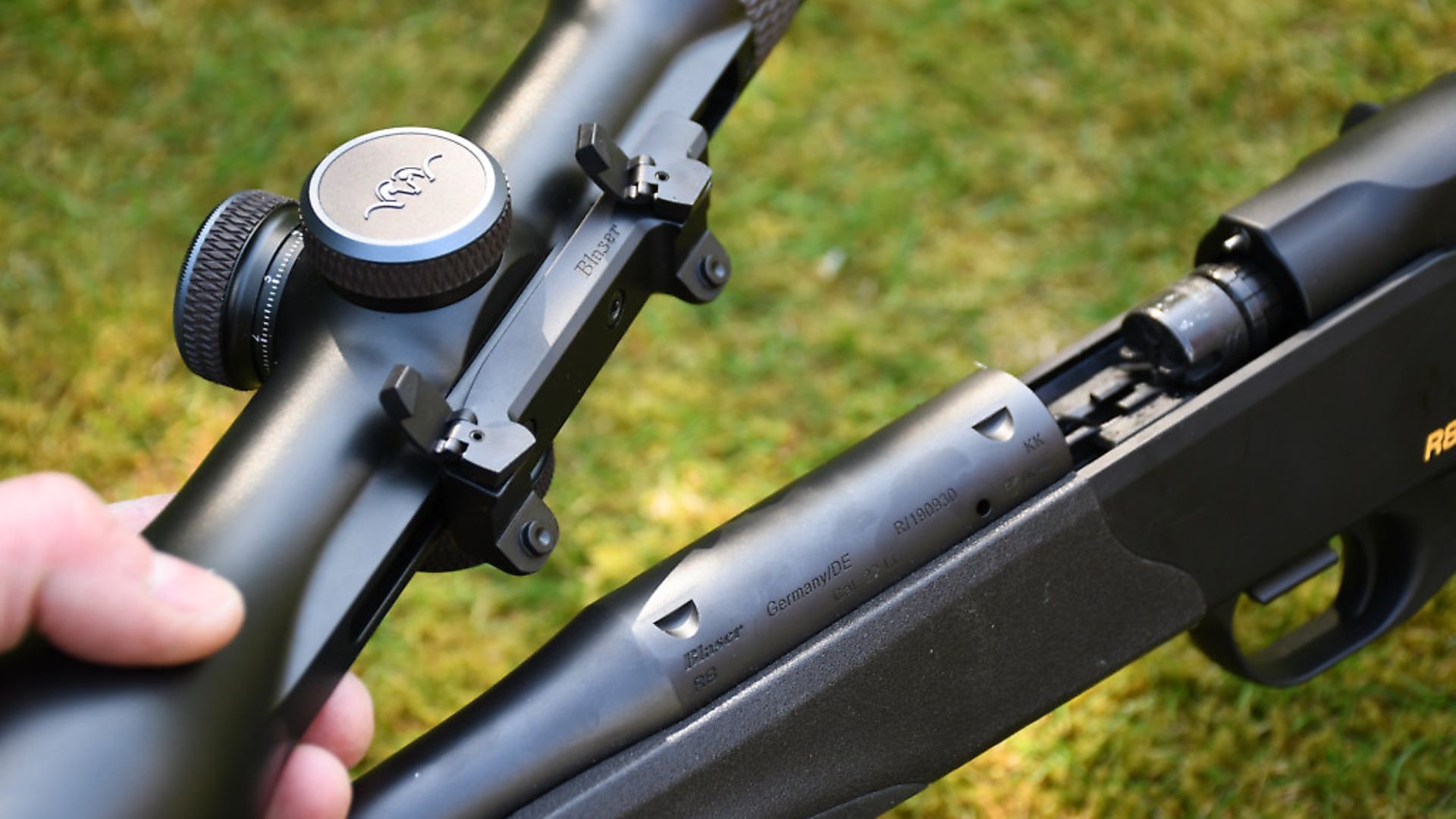 credit: Archant
credit: Archant